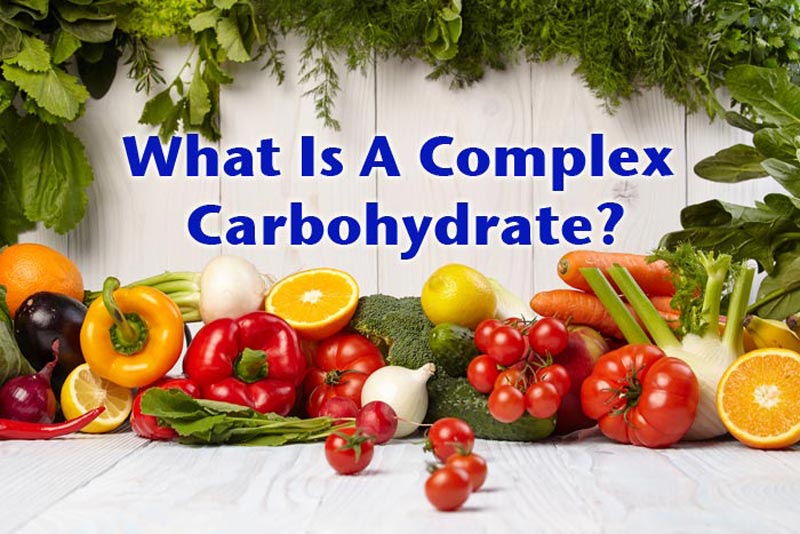Today we're going to talk about complex carbohydrates and go over what they are, examples, and how they are different to simple carbs.

What Is A Complex Carbohydrate?
Complex carbohydrates are long chains of sugars (aka glucose) known as polysaccharides – glycogen, starches, and fiber. You've probably heard that eating complex carbohydrates is better for your health. While that is true, complex carbs are generally a better choice than simple carbs, there is a bit more to it.
For optimal blood sugar control many complex carbohydrate sources still need to be avoided because although the type of carb is important, the amount of carbs is even more important. Many of the complex carbs contain way too many carbs overall, which won't help you control blood sugar and A1C.
So let's go over the different types of complex carbs, and then we'll cover the practical stuff.
Glycogen
You won't hear about glycogen much in the way of the food we eat because there is only a small amount contained in meats. But you may hear of glycogen in the body because when we eat carbs we store some of the glucose as glycogen in the muscles and liver. This gives our body the ability to break it down for use when we need it. Still, it doesn't really relate to the food you actually eat.
Starches
Plants store glucose as starch – giant chains of sugars.
Carbohydrates in the form of starches include potatoes, wheat, rice, other grains like millet, rye, barley, and oats, sweet potatoes, bread, pasta, etc.
Fibers
Fiber is what forms the structure of plants, so different amounts of fiber are found in all sources of plant foods.
There are 2 types of dietary fiber, soluble and insoluble. Soluble means the fiber can dissolve in your stomach water and enzymes and this makes them like a gel that slows down the digestion of foods and slows down the uptake of glucose into the bloodstream.
Insoluble fiber doesn't dissolve but helps to form a lattice-like structure in the digestive tract that cleans out our digestive tract and prevents constipation. Both forms of fiber are very good for us and can help you manage your diabetes. Fiber also helps fill us up and provides many health benefits.
Where do we get these fibers?
Vegetables.
We need to eat LOTS of vegetables, and vegetables are a source of carbohydrate.
Most people don’t realize that vegetables are a source of carbohydrate. Here at DMP, we encourage a low carb diet and many people often say: ‘but don't we need to eat carbs'…
Yes, we do. A low carb diet is a no carb diet!
And thankfully, we can get all the carbs we need predominantly from non-starchy vegetables. If you focus all of your attention on eating vegetables as your main source of carb, you will lower blood sugar and A1C, and be able to manage the long term. This advice is equally as important for people with prediabetes and for general health as well.
Resistant Starch
As a person with type 2 diabetes or prediabetes, it is recommended to avoid most starches as they are very high in carbohydrates, for example, check out this info about flours. However, there are some starches that are ‘resistant starches,' and we need these to feed beneficial gut bacteria. Resistant starches escape digestion in the small intestine and provide fuel to the bacteria in our large intestine. These bacteria generate small chain fatty acids such as butyrate that improve our health, boost immune function and reduce inflammation, amongst other things.
Resistant starch also improve insulin sensitivity, helps lower post-meal blood sugar, and can have a ‘second meal' effect, meaning they help keep blood glucose lower after your next meal too.
We'll share examples below but let's first compare the difference between simple and complex carbs.
Simple and Complex Carb Comparison
This is the general list for both simple and complex carbs so you can see the difference.
SIMPLE CARBOHYDRATES
sugar
white sugar
white flour
white bread
white pasta
soft drinks & sodas
energy drinks
fruit juices
many cereals
many crackers
many sauces and condiments
processed food
ice creams
cakes & cookies
pies
fruit
honey
COMPLEX CARBOHYDRATES
whole grains
whole grain bread
whole grain crackers like brown rice cakes
gluten-free whole grain pasta
brown rice
quinoa
buckwheat
vegetables – loads of them to choose from
beans and legumes such as:
chickpeas
lentils
adzuki beans
borlotti beans
navy beans
wild rice
oats
sweet potato
Please pin, share, or tweet; then keep reading.
Complex carbohydrates are long chains of sugars (aka glucose) known as polysaccharides – glycogen, starches, and fiber. You've probably heard that eating complex carbohydrates is better for your health. While that is true, complex carbs are generally a better choice than simple carbs, there is a bit more to it.
For optimal blood sugar control many complex carbohydrate sources still need to be avoided because although the type of carb is important, the amount of carbs is even more important. Many of the complex carbs contain way too many carbs overall, which won't help you control blood sugar and A1C.
So let's go over the different types of complex carbs, and then we'll cover the practical stuff.
Glycogen
You won't hear about glycogen much in the way of the food we eat because there is only a small amount contained in meats. But you may hear of glycogen in the body because when we eat carbs we store some of the glucose as glycogen in the muscles and liver. This gives our body the ability to break it down for use when we need it. Still, it doesn't really relate to the food you actually eat.
Starches
Plants store glucose as starch – giant chains of sugars.
Carbohydrates in the form of starches include potatoes, wheat, rice, other grains like millet, rye, barley, and oats, sweet potatoes, bread, pasta, etc.
Fibers
Fiber is what forms the structure of plants, so different amounts of fiber are found in all sources of plant foods.
There are 2 types of dietary fiber, soluble and insoluble. Soluble means the fiber can dissolve in your stomach water and enzymes and this makes them like a gel that slows down the digestion of foods and slows down the uptake of glucose into the bloodstream.
Insoluble fiber doesn't dissolve but helps to form a lattice-like structure in the digestive tract that cleans out our digestive tract and prevents constipation. Both forms of fiber are very good for us and can help you manage your diabetes. Fiber also helps fill us up and provides many health benefits.
Where do we get these fibers?
Vegetables.
We need to eat LOTS of vegetables, and vegetables are a source of carbohydrate.
Most people don’t realize that vegetables are a source of carbohydrate. Here at DMP, we encourage a low carb diet and many people often say: ‘but don't we need to eat carbs'…
Yes, we do. A low carb diet is a no carb diet!
And thankfully, we can get all the carbs we need predominantly from non-starchy vegetables. If you focus all of your attention on eating vegetables as your main source of carb, you will lower blood sugar and A1C, and be able to manage the long term. This advice is equally as important for people with prediabetes and for general health as well.
Resistant Starch
As a person with type 2 diabetes or prediabetes, it is recommended to avoid most starches as they are very high in carbohydrates, for example, check out this info about flours. However, there are some starches that are ‘resistant starches,' and we need these to feed beneficial gut bacteria. Resistant starches escape digestion in the small intestine and provide fuel to the bacteria in our large intestine. These bacteria generate small chain fatty acids such as butyrate that improve our health, boost immune function and reduce inflammation, amongst other things.
Resistant starch also improve insulin sensitivity, helps lower post-meal blood sugar, and can have a ‘second meal' effect, meaning they help keep blood glucose lower after your next meal too.
We'll share examples below but let's first compare the difference between simple and complex carbs.
Simple and Complex Carb Comparison
This is the general list for both simple and complex carbs so you can see the difference.
SIMPLE CARBOHYDRATES
sugar
white sugar
white flour
white bread
white pasta
soft drinks & sodas
energy drinks
fruit juices
many cereals
many crackers
many sauces and condiments
processed food
ice creams
cakes & cookies
pies
fruit
honey
COMPLEX CARBOHYDRATES
whole grains
whole grain bread
whole grain crackers like brown rice cakes
gluten-free whole grain pasta
brown rice
quinoa
buckwheat
vegetables – loads of them to choose from
beans and legumes such as:
chickpeas
lentils
adzuki beans
borlotti beans
navy beans
wild rice
oats
sweet potato
Please pin, share, or tweet; then keep reading.

Examples of Best Complex Carbohydrates Sources For Diabetes
While complex carbs are better than simple carbs, they are not all created equal. Some are still high carb foods, while others are lower carb foods that will help you maintain better blood sugar control. So let's take a close look at where all these forms of carbs fall and which ones are best to eat.
FIBERS/ CARBS – EAT MOSTLY THESE
Asparagus
Artichoke
Celery
Tomatoes
Bell pepper
Spring onion/scallion
Leek
Cauliflower
Broccoli
Carrots
Kale
Lettuce
Cucumber
Mushrooms
And more
RESISTANT STARCHES TO INCLUDE
Beans and legumes – small amounts only 1/4 cup per serve
Artichoke
Cashews
CARBS – IN MODERATION
Pumpkin
Onion
Turnip
Celeriac
Swede
Beets
STARCHES/ CARBS TO AVOID
Potatoes
Sweet potatoes
Yams
Plantain
Parsnip
Wheat
Barley
Rye
Millet
Most grains
Bread
Most flour
Rice
And so forth
Choosing the right type of carbs is one of the most important things you can do to get better results with blood sugar and A1c.
Pin it, share it, and tweet it to share the foodie love. Thank you

No comments:
Post a Comment